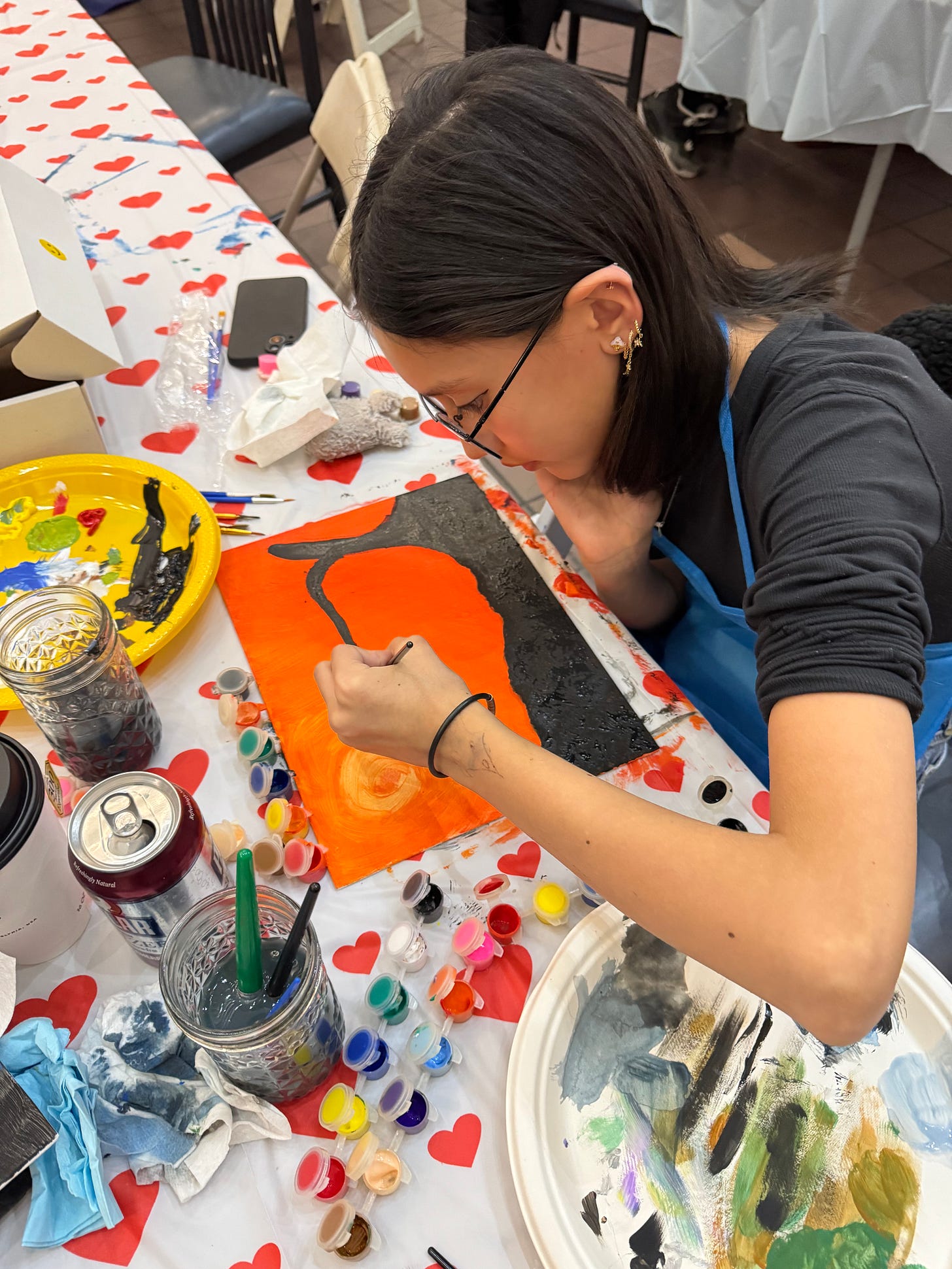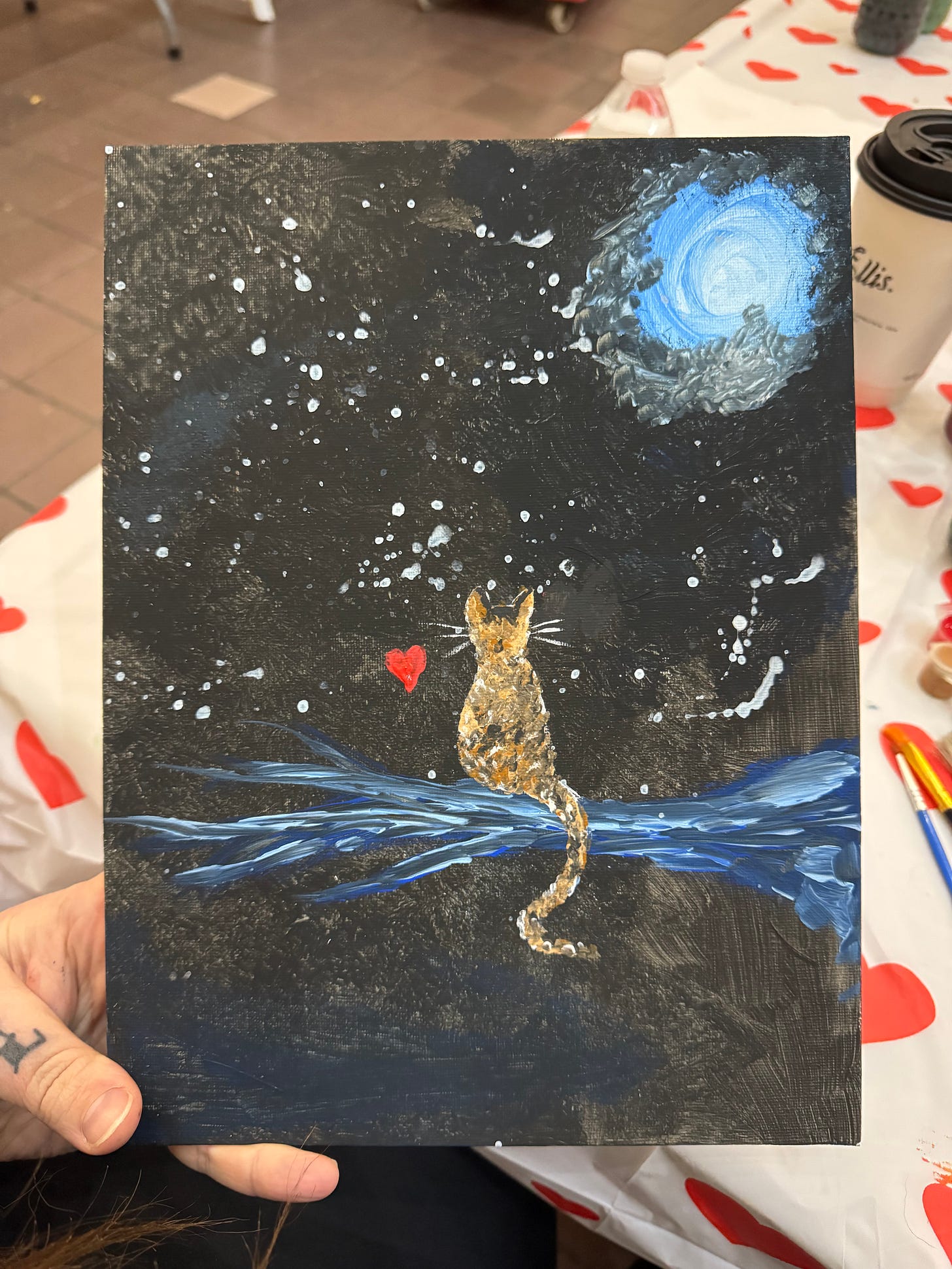If you missed my live Q&A with Narratively, you can catch the replay! Thank you to everyone who was able to join. I harbored a secret fear that no one would show, so hearing kind things from people who were there warmed my anxious heart. To everyone who took an hour out of their Wednesday afternoon to listen to me yap, endless gratitude.
Carolyn and I went to a painting night at her hospital last week. Our invitation came in the form of a phone call from the hospital social worker, an occurrence that I am still getting used to taking in stride.
In an ideal narrative of our post-cancer lives, we’d spend a lot of time at the Philly hospital where Carolyn was in cancer treatment. We’d visit often, just for fun, and each time we’d linger in long, squeezing hugs with the staff who saw us through those years, all of us grateful that Carolyn is alive. Isn’t it wonderful? we’d ask, smiling and shaking our heads before drifting off in a cloud of bliss and gratitude. We’d stay involved, volunteering, donating money and toys, starting fundraisers and wearing themed t-shirts to awareness walks.
In reality, we’ve only gone back to her hospital for her scheduled clinic appointments every three months (or whenever a bruise or ache fuel-injects me with anxiety, which is almost monthly.) Carolyn and I arrive to these afternoon appointments around 12:30, both of us hungry and on edge because she leaves school before lunch and I always forget to pack snacks.
Life post-cancer doesn’t feel like post-cancer. Most days it feels like we’re still in it. A bruise on Carolyn’s leg is enough to send me into an emotional tailspin even if I know it’s from falling off the rock wall in gym class. I still feel sick when I hear the social worker’s voice when I answer the phone for the hospital’s caller ID. I have to box-breathe through invitations to painting nights and sports events. I have to tell myself it’s over, it’s all over, even if over is something we’re only ever striving for.
Each time I cross the hospital’s open atrium, I let it blur around me. The hum of voices from the coffee line runs like a current, overlayed by the whispering shuffle of dozens of footsteps as people move through the building’s open core. I smell my own hot breath behind my yellow paper mask, a tinge of industrial cleaner sneaking through.
The oncology clinic is on the second floor, and we take the elevators up and wait in a waiting room until they call for Carolyn. She fights everyone over getting a butterfly for forty minutes until I promise her something I’ll struggle to deliver on later— overpriced platform boots from Hot Topic, or a night out at hibachi with all her friends— in exchange for a momentary needle prick and a vial of her blood. Then we meet with her oncologist to talk through the results, I hold out hope for no signs of relapse, and we go home.
I have never in my life hung out at her hospital for fun. It seemed an unimaginable action after spending thousands of hours trapped inside, making desperate bargains with the universe to let us go home, let us out.
But the social worker had sounded so excited on the phone. And two years on, it seemed like the right thing to do. We would make art in the scary place, I thought, and somehow it would transform us.
The room was filled with families when we arrived, each of them clustered around a table set with boxes of painting supplies. There were stacks of pizza boxes and plastic buckets of juice and seltzer and coolers full of Drumsticks and ice cream bars. Pairs of parents got their kids settled while nurses and volunteers swooped over to ask what kind of pizza they’d like.
A girl Carolyn’s age sat at the end of our table. Her hair was in the signature pixie cut of maintenance, bangs laying in soft curls across her forehead. A younger girl at the table in front of ours wore a silk scarf knotted at her temple, next to where her eyebrows would eventually grow back in. Some of the kids from the fifth floor came down trailing hospital poles swinging bags of yellow medicine.
It all felt so close. We were just there, I thought. It was like being on the other side of a veil.
I unpacked my box of supplies— a canvas, little plastic pots of paint, brushes, an apron, blotting towels, and a paper plate palette. Carolyn was chatting with a social worker who’d volunteered at her cancer camp the summer before. She was smiling and laughing. I reminded myself to smile, but I felt like if I laughed too hard I might cry.
The instructor’s examples all featured a sun or moon with color radiating out of a bright white orb. The colors could be orange and pink, she said, for sunset, or blue and purple for nighttime, or technicolor for a fever dream— whatever we wanted, whatever we were called to create. Art is about expression, she announced through her in-ear microphone.
I painted concentric circles in purple and blue around a ball of white— the moon. On the other side of the canvas I painted a brushstroked tree in muted green and brown that seemed at odds with my moon. They did not go together, I thought, but the point was to have fun. I finished my canvas in time to catch Carolyn’s frustrated face as she threw her brush down on her paper plate. She’d painted her entire canvas black, aiming for a night sky, and forgot that it would be almost impossible to paint anything else over it.
I’m no good at this, she said.
You get a new canvas, I’ll work on this one, I said, lifting it away from her station with the tips of my fingers and plopping a new blank canvas in front of her. You want me to paint Sally? She nodded, already pouring over the paint pots, plotting a color scheme.
She immediately filled the new canvas with orange and red— a liquid lava sky. She painted a horizon line in black, then filled in the ground with more black. Like in Hawaii, she said, referring to the dried lava fields we’d passed last summer while visiting my Dad . Long black arms of tree branches followed, the dark paint oozing from her brush tip. It looked beautiful but it also scared me.
I coated my brush with blue and blew on the canvas to dry it a bit. I applied the paint in swaths and splotches thick enough that they showed, somewhat muted, against the black sky. First a branch, then a cat sitting on the branch— Sally in dots and flecks, all tawny and white stippling. I wanted to fix the painting for Carolyn without making it mine. I wanted to make it something she could look at and feel a part of.
Carolyn often says that she feels apart from the people around her. She tells me that even though people can’t see it, she knows she has this secret knowledge that they don’t. She speaks a language that no one around her understands. When she has an opportunity to be in a space with other people who share her experience, who know what it’s like to lose their hair or have a tube threaded up their nose or spend a chunk of their childhood wondering if they’re going to make it to High School, it’s her version of pulling in oxygen after a long breath hold.
I finished my part in her painting and showed her. She smiled, then said, I have an idea. She dipped her brush in the white paint and smeared a glob on the paper plate. Then she dunked the brush in her water jar, then back in the paint, turning it into a milky puddle. She fanned the brush with her fingertips and flicked it across the canvas. White droplets splattered across the black paint.
Sally’s looking at the stars, she said.
We left our paintings to dry and walked around to look at what everyone else had made. Each painting was different— in color, in composition, in style. There are a million ways to paint a tree, I thought. There’s no wrong way to paint a sky.
Carolyn walked back to her paintings. She held them up to show one of the nurses who oohed over them and then showed them off to the instructor who oohed over them some more. As I crumpled the disposable tablecloth, gathering the open paint tubs and smeared paper plates, Carolyn held up the Sally painting.
We did it together!
I thought about all the years we’d spent moving through this space, wondering at the outcome, terrorized by the tenuousness of her future. A bubble of tension that had been slowly expanding inside of my chest for the better part of two years burst.
Yes, we did.
Next week I’ll be doing a breakdown of how my Narratively piece came to be, from pitch to draft to publication. It was a ten month process, and I’m excited to offer insight into the whole thing— including my many avoidable mistakes!
I’ll also share information about opportunities to learn from and work with me in the coming months. If you’re looking for gentle guidance (or hardcore accountability, she contains multitudes!) I’m opening up some space to work both in group settings and 1:1.
I love helping other writers succeed and I’ve found the best way to do that is to share what I’ve learned. Whatever the opposite of a gatekeeper is, think of me as that!








Elizabeth, thank you for sharing this. I can feel all your different emotions as you go through the process of returning for the creative day at the hospital. The paintings turned out gorgeous, a team effort indeed. Much love x